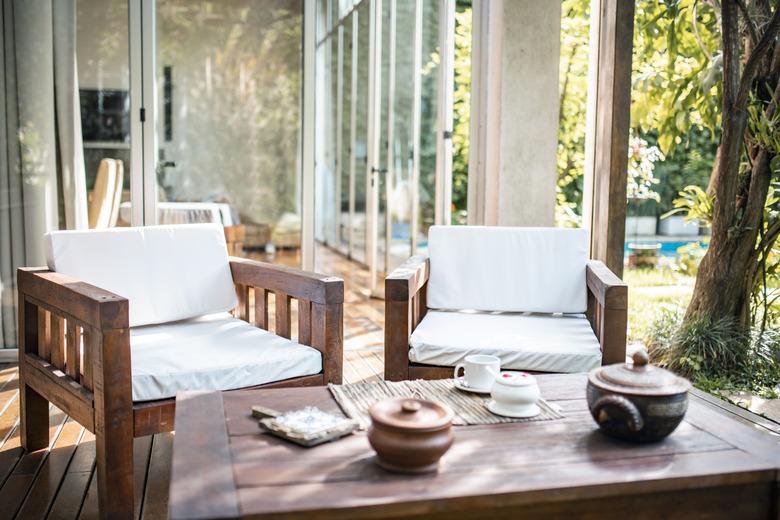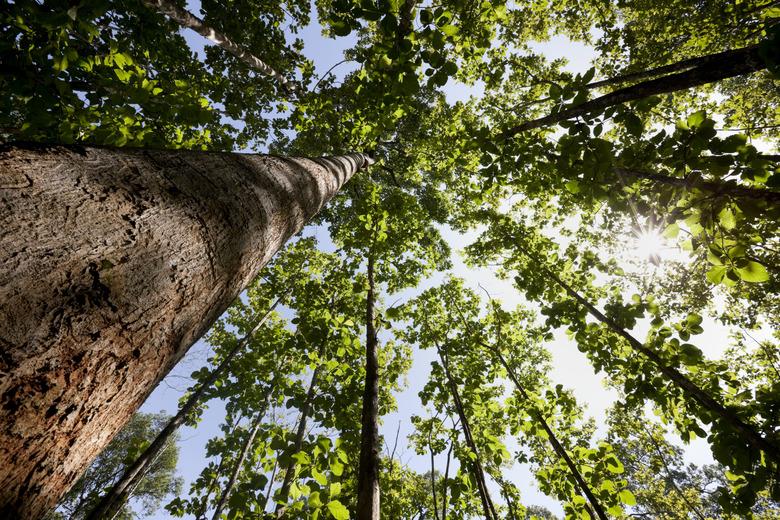Teak Wood Vs. Mahogany
The tropical hardwoods are among the many tree species used for making fine furniture, musical instruments, yachts, and a multitude of other items. While teak (Tectona grandis) and mahogany (Swietenia macrophylla) are the primary species, there are other trees called "teak" and "mahogany" that are also used for lumber. When selecting wood for your projects, verify with your supplier that it is the correct species of teak or mahogany before finalizing your purchase. Here's what to know about teak versus mahogany.
About Teak Wood
Native to South and Southeast Asia, India, and the surrounding tropics, teak grows up to 150 feet tall. While still found in the wild, much of the teak harvested today is grown in plantations in Africa, India, Central America, and South America. It is an oily wood that is gold to medium brown. Hardy in U.S. Department of Agriculture plant hardiness zones 10 through 12, plantation teak is a strong, rot-resistant wood used for a variety of decorative items and furniture designed for wet and outdoor environments.
Other trees that are known as teak include:
- African teak (Chlorophora excelsa).
- Kapur or Borneo camphorwood (Dryobalonops spp.).
- Other Tectona species.
African teak is used as an alternative to plantation teak and has a golden orange color that turns dark brown upon being exposed to light. Kapur is found in reddish- to pinkish-brown with a medium texture and a strong camphor smell. It is also used in furniture, veneers, paneling, and framing.
About Mahogany Tree Species
The "real" mahogany trees used in woodworking and for building fine furniture are Swietenia macrophylla, Swietenia mahagoni, and Swietenia humilis. Swietenia macrophylla is found in the Caribbean and in South America and is known as the bigleaf, Caribbean, Honduran, and Venezuelan mahogany, while Mexican mahogany (Swietenia humilis) grows from Mexico to South America. Swietenia mahagoni is native to south Florida and Cuba, and while it can be used for lumber, it is currently grown as a landscape and street tree. Mahogany is hardy in USDA zones 10 through 12, depending on the species.
Generally, bigleaf or Honduran mahogany is the genuine mahogany available in lumber yards. It is plantation-grown in Fiji, India, Indonesia, the Philippines, and other tropical southeast Asian islands and countries. Mahogany has a Janka hardness rating of 800 to 900.
Among the many other tree species that may be labeled and/or used as a substitute for mahogany are:
- African mahogany (Khaya grandifoliola and Khaya senegalensis).
- African padauk (Pterocarpus soyauxii), which is similar to African mahogany.
- Andaman padauk (Pterocarpus dalbergioides), known as East Indian mahogany and Indian redwood.
- Philippine mahogany (Shorea spp.), known as lauan.
- Santos mahogany (Myroxylon balsamum).
- Sapele (Entandrophragma cylindricum).
- Utile (Entandrophragma utile), also known as sipo mahogany.
Teak vs. Mahogany
Aside from being tropical hardwoods, teak and mahogany are similar in many other ways:
- Used for fine furniture and wood carving.
- Strong and durable.
- Termite resistant; older mahogany trees are more resistant than plantation-grown trees.
- Endangered in the wild; sustainably grown in plantations.
- Allergic reactions in sensitive individuals include irritation to the eyes, skin, and respiratory system.
- Expensive, with teak being higher in price than mahogany.
- Accept water- and oil-based stains and finishes.
The differences, however, are significant when working with the wood. Among the ways that teak and mahogany differ are:
- Color: Teak is a yellowish to golden brown, while mahogany is a deep reddish-brown.
- Pattern: Mahogany's grain can be tight and linear, interlocking, or wavy, and you may occasionally spot rings, while teak has a straight to slightly wavy grain.
- Texture: Teak has a coarse texture, while mahogany has a medium texture and a natural luster.
- Odor: Teak smells like leather when freshly cut. Mahogany doesn't have a distinct scent.
- Oil content: Teak has a high oil content, making it both durable and harder to glue.
- Water resistance: The oil content of teak makes it more water-resistant than mahogany, although both are used in shipbuilding.
- Indoor and outdoor use: Teak is suitable for both, while mahogany is generally for indoor use only.
- Veneer: Mahogany is used as a veneer, such as with mahogany plywood panels.
- Janka hardness rating: Mahogany ranks at 800 to 900, while plantation teak is ranked at approximately 1,070.


